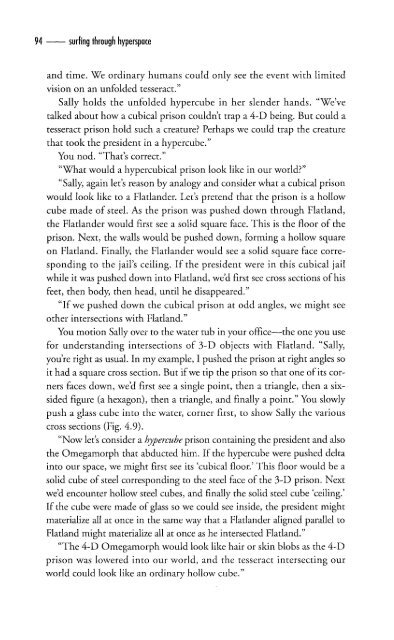clifford_a-_pickover_surfing_through_hyperspacebookfi-org
clifford_a-_pickover_surfing_through_hyperspacebookfi-org
clifford_a-_pickover_surfing_through_hyperspacebookfi-org
Create successful ePaper yourself
Turn your PDF publications into a flip-book with our unique Google optimized e-Paper software.
94 <strong>surfing</strong> <strong>through</strong> hyperspace<br />
and time. We ordinary humans could only see the event with limited<br />
vision on an unfolded tesseract."<br />
Sally holds the unfolded hypercube in her slender hands. "We've<br />
talked about how a cubical prison couldn't trap a 4-D being. But could a<br />
tesseract prison hold such a creature? Perhaps we could trap the creature<br />
that took the president in a hypercube."<br />
You nod. "That's correct."<br />
"What would a hypercubical prison look like in our world?"<br />
"Sally, again let's reason by analogy and consider what a cubical prison<br />
would look like to a Flatlander. Let's pretend that the prison is a hollow<br />
cube made of steel. As the prison was pushed down <strong>through</strong> Flatland,<br />
the Flatlander would first see a solid square face. This is the floor of the<br />
prison. Next, the walls would be pushed down, forming a hollow square<br />
on Flatland. Finally, the Flatlander would see a solid square face corresponding<br />
to the jail's ceiling. If the president were in this cubical jail<br />
while it was pushed down into Flatland, we'd first see cross sections of his<br />
feet, then body, then head, until he disappeared."<br />
"If we pushed down the cubical prison at odd angles, we might see<br />
other intersections with Flatland."<br />
You motion Sally over to the water tub in your office—the one you use<br />
for understanding intersections of 3-D objects with Flatland. "Sally,<br />
you're right as usual. In my example, I pushed the prison at right angles so<br />
it had a square cross section. But if we tip the prison so that one of its corners<br />
faces down, we'd first see a single point, then a triangle, then a sixsided<br />
figure (a hexagon), then a triangle, and finally a point." You slowly<br />
push a glass cube into the water, corner first, to show Sally the various<br />
cross sections (Fig. 4.9).<br />
"Now let's consider a hypercube prison containing the president and also<br />
the Omegamorph that abducted him. If the hypercube were pushed delta<br />
into our space, we might first see its 'cubical floor.' This floor would be a<br />
solid cube of steel corresponding to the steel face of the 3-D prison. Next<br />
we'd encounter hollow steel cubes, and finally the solid steel cube 'ceiling.'<br />
If the cube were made of glass so we could see inside, the president might<br />
materialize all at once in the same way that a Flatlander aligned parallel to<br />
Flatland might materialize all at once as he intersected Flatland."<br />
"The 4-D Omegamorph would look like hair or skin blobs as the 4-D<br />
prison was lowered into our world, and the tesseract intersecting our<br />
world could look like an ordinary hollow cube."







